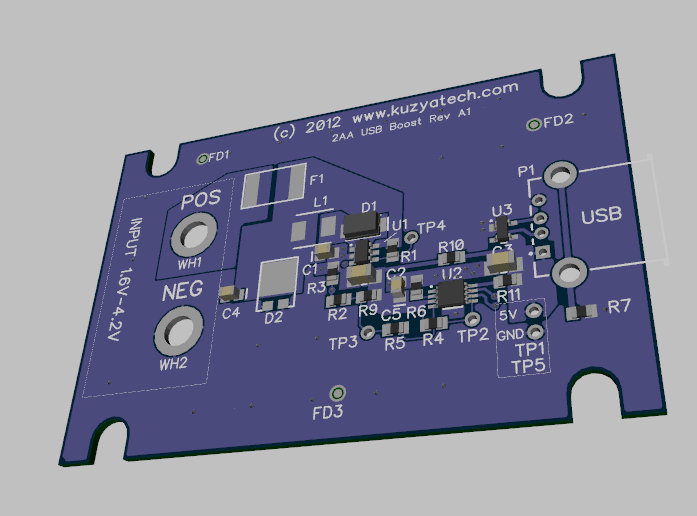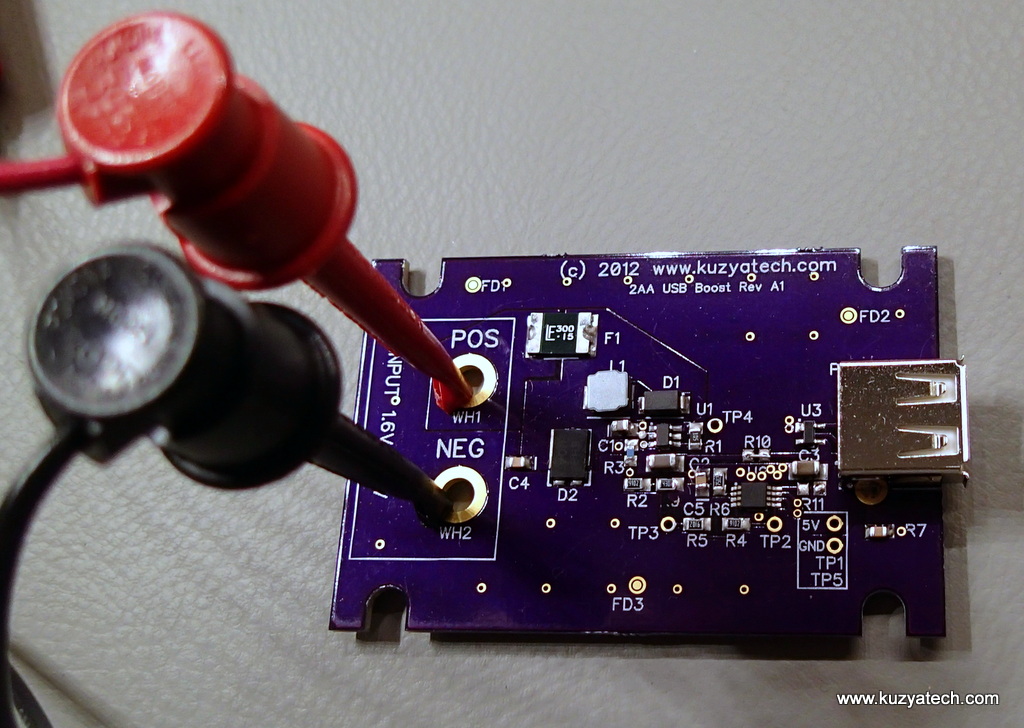As some of you know, I’ve recently traveled to Boston for the ESC/Design East conference. While that was fun, what quickly became a problem was my phone’s limited battery life. I’d leave in the morning with full charge, and by about 4PM each day it’d be asking for a charger. Normally it’s not a problem, except when you are in a new city and relying on your phone as a your navigation aid. There are obviously commercial solutions- a spare battery or a rechargeable battery pack or theOSHW ones such as Adafruit’s MintyBoost. MintyBoost was the closest to what I was looking for, but still not quite it. So I set out to make my own.The first way of doing things differently was to use a TI TPS2511 charge controller I’ve talked about in http://kuzyatech.com/part-of-the-week-ti-tps2511. The idea is that instead of using fixed resistors on USB data lines (that are different for each device type, you use a chip that does all the negotiations with the device and keeps it happy and charging. (And there is a lot of negotiations with some newer products and tablets.) Then we couple that with a good boost converter and we get a magic box that can charge anything USB. After brute forcing my way through the whole Digikey catalog, I settled on Linear Tech LTC3426 with a SOT package and pretty good characteristics.
So I’ve whipped together a design that combined a bit of input protection (reverse, ESD, and a short circuit), boost converter and a TPS2511 circuit.
First tests with DC supply feeding the board looked very good. I could see negotiation happening on the USB lines with my newish digital camera plugged in, and it showed “connected to charger” message instead of the “connected to the computer” one. My smartphone did the same and was happily charging.
| DCIN @0.44A | ||||
| Vin,V | Iin,A | Vout | Iout | Eff |
| 3 | 0.83 | 4.93 | 0.44 | 87% |
| 2.4 | 1.08 | 4.93 | 0.44 | 84% |
| 2.27 | 1.21 | 4.93 | 0.44 | 79% |
| 1.97 | 1.51 | 4.93 | 0.44 | 73% |
| 1.67 | 2.09 | 4.93 | 0.44 | 62% |
| 1.5 | OFF | OFF | OFF | |
| DCIN @0.5A | ||||
| Vin,V | Iin,A | Vout | Iout | Eff |
| 3.3 | 0.87 | 4.93 | 0.5 | 86% |
| 3.1 | 0.91 | 4.93 | 0.5 | 87% |
| 2.87 | 1.04 | 4.93 | 0.5 | 83% |
| 2.69 | 1.14 | 4.93 | 0.5 | 80% |
| 2.45 | 1.27 | 4.92 | 0.5 | 79% |
| 2.25 | 1.43 | 4.92 | 0.5 | 76% |
| 2.02 | 1.67 | 4.91 | 0.5 | 73% |
| DCIN @1.04A | ||||
| Vin,V | Iin,A | Vout | Iout | Eff |
| 3.29 | 1.96 | 4.93 | 1.04 | 80% |
| 3 | 2.2 | 4.91 | 1.04 | 77% |
| 2.85 | 2.33 | 4.7 | 1.04 | 74% |
| 2.45 | 2.36 | 3.9 | 1.04 | 70% |
After collecting a bit of test data, I’ve proceeded to testing with actual batteries as an input source. And here we find the first problem. With TPS2511 in place, the device is thinking it’s negotiating with the charger, that is capable of delivering either 5W or 10W of power. And while the LTC3426 is capable of delivering 5W with reasonable input voltage, standard AA batteries are not. So their voltage starts dipping almost immediately, raising input current into the boost converter until it starts limiting and lowering output voltage. So pretty quickly we find ourselves with barely enough output voltage to charge anything. And by that point batteries are dead. Not very good…The second “woops” was an attempt to use TP2511 CS pin to trim Boost converter’s output to compensate for USB cable drop. Well, LTC4326 does not allow its output to go over 5V. And the third woops (known from the beginning) is the power consumption of both chips. TPS2511 draws 200uA or so when active, while LTC3426 is almost 1mA. That means we probably can’t leave batteries in the unit when not being used. I suppose I could only install batteries when I need to charge something, or a manual switch and a corresponding opening in the enclosure is in order.
Conclusion: the first prototype kinda worked but it appears the architecture selected was not very well thought through. TPS2511 is designed to be powered by a wall charger or other “unlimited” source, not a small set of batteries. So mating it with a power supply capable of delivering 5W, but batteries that are not is not a very good idea. Sounds like it’s back to drawing board!


